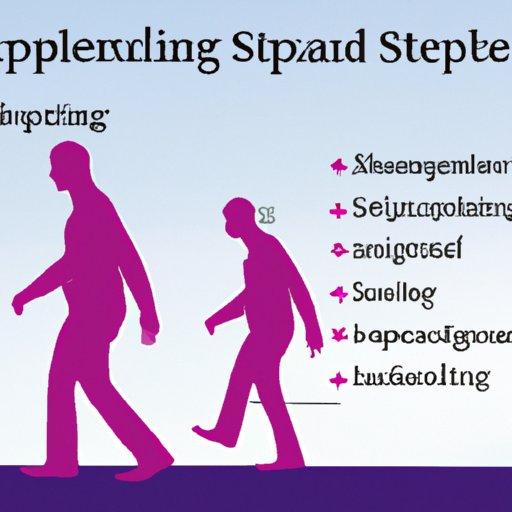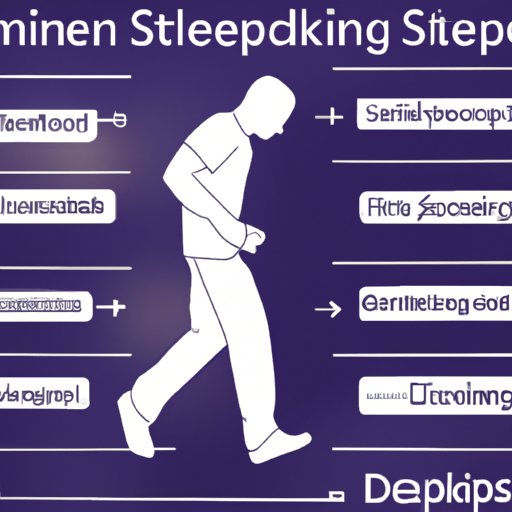Introduction
Sleepwalking, also known as somnambulism, is a disorder that occurs during deep sleep. It involves engaging in activities such as walking, talking, eating, or even driving while asleep. Sleepwalking is more common in children than adults, but it can occur at any age. It is estimated that around 3-4% of adults experience sleepwalking at least once in their lifetime.
Examining the Causes and Symptoms of Sleepwalking
The exact cause of sleepwalking is not known, but there are certain biological and environmental factors that have been linked to the condition. These include genetic predisposition, sleep deprivation, stress, alcohol consumption, and certain medications. Other contributing factors may include fever, fatigue, and sleep apnea.
Common symptoms associated with sleepwalking include waking up in an unfamiliar place, confusion upon awakening, and difficulty remembering details about the event. In some cases, sleepwalkers may exhibit physical activity such as running, jumping, or even attempting to drive a car.

Exploring the Relationship Between Sleepwalking and Genetics
Recent research has suggested that sleepwalking may be hereditary. Studies have shown that children whose parents were sleepwalkers are more likely to experience sleepwalking themselves. This suggests that genetic factors play a role in the development of the disorder.
Genes are believed to affect how the brain regulates sleep cycles. Abnormalities in certain genes may lead to disruptions in the normal sleep cycle, which can trigger episodes of sleepwalking. However, further research is needed to understand the exact role of genes in the development of the disorder.
Investigating the Potential Health Risks Associated with Sleepwalking
Sleepwalking can pose serious health risks. People who suffer from the disorder are at increased risk of accidents and injuries due to their impaired state. They may also be more prone to falls, cuts, bruises, and even fractures. Additionally, sleepwalking can lead to mental health issues such as anxiety, depression, and post-traumatic stress disorder (PTSD).

Understanding the Diagnosis and Treatment of Sleepwalking
If you suspect that you or someone you know is suffering from sleepwalking, it is important to seek medical help. A doctor will conduct a physical exam and ask questions about your sleep habits in order to diagnose the disorder. Additional tests may include blood work, EEGs, and sleep studies.
Treatment options for sleepwalking vary depending on the severity of the condition. Common treatments include lifestyle changes (such as avoiding alcohol before bedtime), medication, and cognitive behavioral therapy. In some cases, doctors may recommend hypnosis or relaxation techniques to reduce the frequency of sleepwalking episodes.

Examining the Effects of Sleep Deprivation on Sleepwalking
Sleep deprivation is one of the most common triggers of sleepwalking. Therefore, it is important to get enough quality sleep each night in order to reduce the risk of sleepwalking. It is recommended that adults get 7-8 hours of sleep per night, and children should aim for 10-12 hours. Additionally, avoid caffeine, alcohol, and other stimulants before bedtime.
Conclusion
Sleepwalking is a disorder that affects millions of people worldwide. Although the exact cause is unknown, it is believed to be related to genetic factors and environmental triggers such as sleep deprivation. It is important to seek medical help if you suspect that you or someone you know is suffering from sleepwalking, as it can pose serious health risks. Treatment options vary depending on the severity of the condition, but lifestyle changes, medication, and cognitive behavioral therapy can all help to reduce the frequency of episodes. Finally, getting enough quality sleep each night and avoiding stimulants before bedtime can help to prevent sleepwalking.
(Note: Is this article not meeting your expectations? Do you have knowledge or insights to share? Unlock new opportunities and expand your reach by joining our authors team. Click Registration to join us and share your expertise with our readers.)
